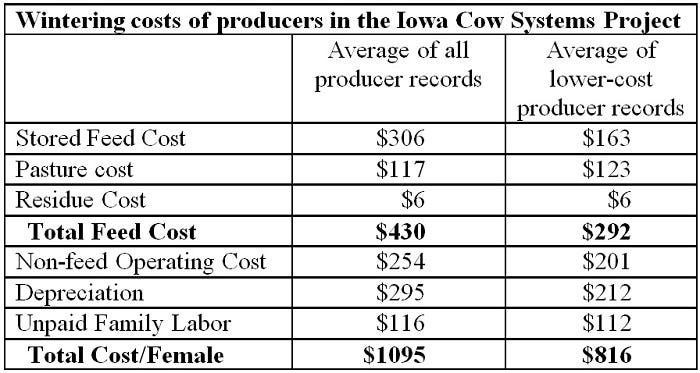February 19, 2019

By Erika Lundy
New data from Ohio confirms operations that control winter feed costs are more likely to attain profitability.
In fact, controlling input costs is much more manageable than controlling outputs such as weaning weights or the market price.
Because feed costs remain the largest expense for cow herds in northern climates, it is important to remember that reducing feed costs without sacrificing productivity is critical.
For the past three years, Iowa State University beef extension field specialists have been working with 24 cooperating producers across Ohio to collect production and financial data to help develop best management practices within several cow-calf systems. These include limit-grazing, traditional grazing, and extensive grazing operations. Within this producer dataset, feed costs accounted for half of the direct cost of raising beef. For comparison purposes, the least-cost third of records were separated from the average of participating operations (See the table).
For the lower-cost producers, allowing the cows to harvest more of their own feed reduced stored feed costs by 50%.
When put on a per-cow basis, lower-cost producers were providing 1.8 tons of stored feed per year on a dry-matter basis, while the average producers in the study were providing 3.25 tons of stored feed per cow per year on a dry-matter basis.

Often, limited pasture acres become a challenge to implement stockpiled grazing as a method to extend the grazing season. However, there are other resources including grazing crop residue and cover-crop acres to reduce dependence on stored feed.
Previous data from ISU Standard Performance Analysis (SPA) and several other beef cow business records indicated that producers who use crop residue as a feed resource can greatly decrease winter feed costs.
Participants in this study who use corn residue as a feedstuff were able to extend the grazing season an additional 56 days at a cost of $11/cow, on average.
There may be instances where an early corn harvest allows for pasture to recover while cows are grazing corn residue. Depending on the weather, many operations can delay providing stored feed until after the first of the year when using both corn residue and stockpiled grazing practices.
Another advantage the lower-cost producers may have is controlling feed waste. The industry has made vast improvements in hay feeder types in the last few years with an emphasis on minimizing hay waste. Further, if you have capabilities of delivering a total mixed ration (TMR) into some form of a feed bunk system, feed waste can be minimized and you have more control on pounds of feed delivered.
Those who live near ethanol plants can sometimes source corn byproducts for a relatively cheap, high-protein and high-energy feed resource to incorporate into beef cow diets. Corn byproducts coupled with low-quality forages offer an opportunity to offer a nutrient-dense diet with the capability of limit feeding females.
Remember that testing forages and other feedstuffs like corn coproducts allow you to better match your feed resources with cow requirements.
Further, the lower-cost producers in this study didn't all have one methodology. Records from all three production systems were included in the low-cost group, indicating that with the proper set-up and management control of feed cost and waste, limit-grazing situations can be low-cost as long as non-feed costs such as building and machinery costs are kept low.
Thus, management and capitalizing on various feed resources may be more important than the type of management system you employ.
Lundy is a beef specialist with Iowa State University.
You May Also Like




